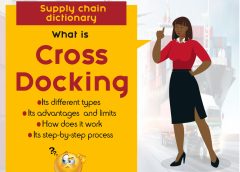Cross-docking refers to a method consists of moving goods from the arrival docks to the departure docks without putting them back in the warehouse. The cross-docking operation is based above all on careful sorting of the packages, which is essential to guarantee the continuity of the distribution chain. As a general rule, goods packages do not remain on the receiving site for more than 24 hours. They are forwarded for delivery on the same day or the day after their arrival at the unloading platform, which makes cross-docking an ideal solution for urgent or high-priority orders.
- The different types of cross-docking
There are currently three types of cross-docking applicable in the logistics warehouse:
> Direct cross-docking, also known as pre-distributed cross-docking, is the easiest method to implement. It consists of getting the goods at the receiving docks and loading them immediately after they have been classified in situ. This is the most commonly used cross-docking method in logistics and transport warehouses;
> Indirect or consolidated cross-docking adds an order picking activity to direct cross-docking. De-palletising and classification of goods can be carried out before loading onto the outbound docks. This type of cross-docking is very common in automotive and retail platforms;
> Hybrid or mixed cross-docking combines new goods with other goods already in storage. This technique combines direct and indirect cross-docking.
-
Advantages and disadvantages of cross-docking
What are the advantages of cross-docking for the logistics business?
Cross docking is used during peak periods in the warehouse and has many advantages for both the company and the customer. The result is better responsiveness and optimisation of all costs related to goods logistics.
> Reducing delivery times and improving customer satisfaction
By eliminating certain logistical steps, in particular stockpiling, cross-docking allows for significant time savings. This means that goods can be dispatched more quickly, as can the delivery of products. A faster delivery of goods inevitably leads to greater overall satisfaction and added value for the transport company.
> Reduction of logistics costs related to goods
Cross-docking means that storage and maintenance of stocks is eliminated. As a result, logistics costs are significantly reduced, and the savings can be used for other activities to improve the overall operation on site.
> Optimising the properties of perishable goods
Certain fragile goods or goods with a use-by date require rapid processing in the warehouse to keep their properties intact. This may include fresh products for which the short transit time offered by cross-docking seems particularly appropriate.
> An optimal and sustainable supply chain
The sorting and classification of goods in relation to cross-docking significantly optimises the organisation and planning of transport for parcel delivery. This results in a relatively significant reduction of the carbon footprint generated during the drivers’ rounds.
> The limiting factors of cross-docking
To ensure that the cross-docking logistics method works optimally, a certain amount of organisation is required.
> Essential planning between all supply chain participants
In order to ensure that the processing and delivery of goods is carried out correctly, it is important to ensure that the various parties involved work in perfect synchronisation.
To do this, a hierarchy of tasks is necessary, under the guidance of a warehouse supervisor who controls :
- the reception of goods;
- the management of parcel sorting;
- fast and optimised shipment of goods.
> Tools integrated into the logistics platform
Cross-docking must be supported by the use of tools to facilitate organisation and communication within the warehouse. To achieve this, logistics platform sites must be equipped with software such as a TMS (Transport Management System) or a WMS (Warehouse Management System) or apply specific, standardised procedures.
> A sometimes expensive start-up cost
Although cross-docking can generate cost savings, it does require a sometimes substantial initial investment in the development of transit areas and the optimisation of transport and delivery rounds.
-
How cross-docking logistics works
Implementing cross-docking logistics within the logistics organisation requires several steps and processes to be followed in order to support its optimal use.
- Cross-docking steps and process
Cross-docking is a step-by-step process:
- distribution planning and delivery of orders ;
- receipt of packages at the unloading dock ;
- quality control and registration of goods received ;
- repackaging, consolidation and dispatch of packages for delivery.
source : viapost.eu






